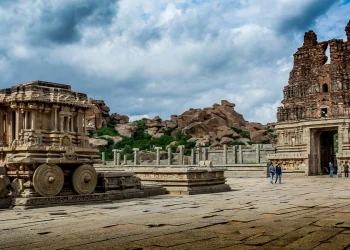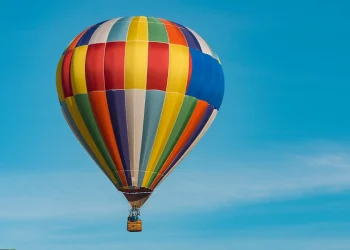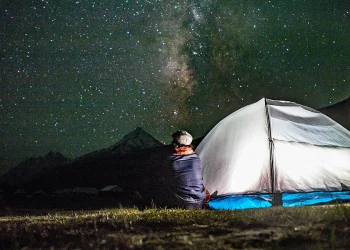Over the years whilst living in Syros, (the administrative capital of the Cycladic group of Islands – Kyklades in Greek), I had heard occasionally from different folks what an attractive and unique island Sifnos was. It was said to have an exquisite dreamlike quality.
Not so far away … Sifnos is in the chain that forms the western arc of the Cyclades, and can be seen from the southern end of Syros some 24 nautical miles away.
Every year I try and venture to two or three of the other islands around Greece … always somewhere new. In 2021 I went to Kythnos and Milos, both also in this western arc.
Table of Contents
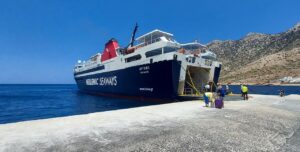
And so it was that recently I boarded the charming “Artemis” ferry, one of the smaller boats in the Hellenic Seaways fleet, for the four hour trek to Sifnos. On the way we stopped at Paros and Serifos, before arriving early afternoon.
Sifnos
Sifnos is medium in size by Greek standards … approx 15 kms in length and approx 8 kms in width. It has an area of approx 74 square kilometres, with its highest point being 680 metres (location of the Monastery of Profit Ilias) … and a permanent population of approx 2,650 people.
It is known for its traditional pottery and there are many small workshops in the villages … and its “hiking trails”. It has become the most popular destination in the Western Cyclades. Visitors flock to the island in summer lured by its charming villages, terraced countryside dotted with ancient towers, Venetian dovecotes and long sandy beaches.
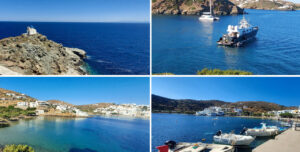
Day 01
First impressions are often the most revealing and the delightful port of Kamares on the west coast of the island doesn’t disappoint. As you enter the deep bay one is taken back by the height of the rocky hills that form a grand amphitheatre effect. On the hill tops are several tiny isolated white dots which I would learn later are Greek Orthodox Monasteries.
Typical of the Cyclades it has a dry rocky terrain. It has been this juxtaposition of the dry barren grey rock meeting the royal blue Aegean Sea that has always held an intrinsic appeal and fascination for me.
As you depart the ferry, in the distance (approx 500 metres) on the other side of the bay one can see the outline of a stunning white sandy beach. The many beach umbrellas suggest that the tourists are entrenched and a welcome and necessary part of the island’s economy.
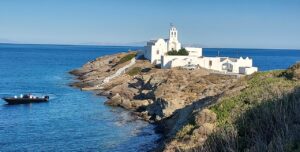
As a true backpacker (in search of that youthful feeling of being adventurous and free), I had not organised my accommodation for the anticipated three nights . So the first stop was the Information Office located on the port.
Because of the internet, sadly gone are the days of the friendly locals welcoming you with their quaint hand made signs … promoting their accommodation on offer with their broad smiles, and imploring you to “pick me”.
In my backpacking youth around these unique Islands I had always been amazed at how courteous they were with each other, despite competing for your favour.
A friend had told me that whilst the port of Kamares definitely has a holiday atmosphere with its large beach and waterfront cafes and tavernas, the real action is up near Apollonia … the island’s capital approx 5 kms away to the east.
So my budget accommodation was efficiently organised by the delightfully friendly receptionist, after making a few phone calls on my behalf.
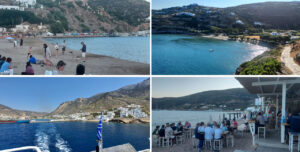
Whilst I was very tempted to stay in Kamares which was visually attractive with loads of accommodation to be seen, I decided to stick with the advice received.
My second pleasant encounter with the accommodating locals was the obliging communicative bus driver, and his attractive teenage assistant collecting the fares.
So far, so good … my first impression of the locals was pleasant. This came as a relief as Greek bus drivers in the busy summer months on the more touristy islands can be far less communicative . This was definitely in keeping with Sifnos’s reputation for being “low key and chilled”.
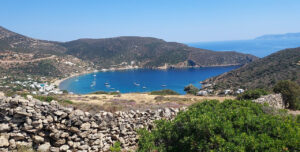
The twenty minute bus ride up a steep and winding road to Apollonia was an insight into what the island’s topography would offer. Up into the centre the rugged rocky landscape is interspersed with green out crops of the low height ubiquitous Skinos plant … (more green than my home island of Syros), with the ever present white with blue Cycladic cubic houses scattered about.
The two star budget rooms of “Kalarides” with host Yiannis was all that was needed, being clean tidy and just a 5 minute walk up into the town centre.
Apollonia is the capital of the island and forms the nucleus of a collection of villages all within a 2 km radius ( Artemonas, Kato Petali, Katavati, Exampelas, Ano Petali). It is a very pleasant small town with the typical Town Square located on the main road thru the middle.
There is a lovely modern bakery offering daily fresh baked goodies and a comfortable outside seating area to watch the world go by. This was quickly established as my ground zero for the obligatory morning caffeine fix and croissant … to kick start my day.
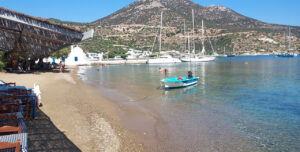
Having had an early 6 am start it was even more necessary than usual to seek refuge from the afternoon heat, and go horizontal for an hours siesta. At Yiannis’s suggestion I took an evening stroll up to the smaller neighbouring village of Artemonas, (Apollonia’s twin village).
It is a delightful up market enclave with impressive venetian houses and the charming 17th century church Agios Georgios tou Afendi. In all my travels around Greece I never tire of visiting these elegant very colourful Orthodox churches, with their domed ceilings and splendid ornate murals of biblical folk.
Day 02: Kastro
The following day I set off on the 3 km one hour walk to the island’s biggest tourist attraction, and a must see … that is Kastro (Castle) on the east side of the island. It offers magnificent panoramic views of the Aegean with Paros and Ante Paros a faint outline in the hazy distance.
Kastro is walled cliff top medieval village that was once the capital of the island. It is a magical place … a labyrinth of winding ally ways and white washed houses, hanging off the eastern edge of the island.
It is up to this day one of the most important medieval settlements in the Cyclades and indeed all of Greece. It is best to enter the village by using the peripheral path around the sea side, to enjoy the stunning views of the majestic royal blue Aegean … before sighting the well recognised church below.
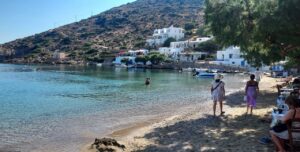
The iconic “Church of the Seven Martyrs” is located below Kastro on a neck of land jutting about 50 metres out to sea. Whilst only small it is the most symbolic church on the island and one of the most photographed spots in the Cyclades. This is a special place … truly quintessential island Greece !
Sadly on the day I hiked out there the front and only door was locked. … no doubt for protection from the madding tourists like myself !
In Kastro a coffee or something a little stronger can be enjoyed in the up market “Dolci” Cafe Restaurant perched on the western side of the village, offering panoramic views of the hinterland valleys, I suggest a full day should be devoted to exploring this amazing settlement, with a lunch at one of the few delightful Tavernas. I regret only spending half a day there !
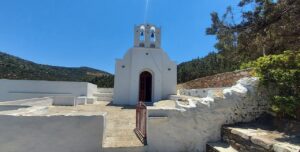
Faros
Another enjoyable adventure was to take the bus from Apollonia ( regular summer time hourly service ) down to the attractive beach settlement of Faros approx 6 kms away on the south east corner of the island.
There is a small yachting marina jetty that brings life to the village … and there are two very pleasant beaches (with several tavernas and cafes) connected by a path thru a small headland with houses. Both have tamarisk tress offering shade for the beachgoers, within the horse shoe shaped bay.
I found my way to the second beach and enjoyed a splendid swim in the crystal clear water. For me the Greek Islands are all about connecting with the truly unique Aegean Sea … and there is no better way than swimming in the safe clean waters on offer.
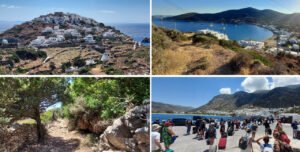
Chrisopigi Monastery
I then noticed the sign arrow advertising “Path to Chrisopigi” . The Monastery of Panagia Chrisopigi is another famous church located on a slither of land, protruding 100 metres into the sea.
The one hour walk along the man made path which meanders approx 2 kms around the seas edge to Chrisopigi, is one of the most picturesque you could expect in these subliminal islands. At around 8pm with the setting sun in the west, this was a surreal experience.
The Monastery of Panagia Chrisopigi is another of the famous landmarks on Sifnos. (Protector Saint Chrisopgi of the island) The monastery was built on top of an older church and is located on top of a rock, literally upon the sea. Another major tourist attraction and well worth visiting.
Day 03 – A serious hiking adventure
Having been intrigued by the “hiking phenomenon” that was obviously all about the island, I decided to investigate what was on offer.
Sifnos has developed into a hikers paradise with19 designated trails criss crossing the island. Free detailed maps are available from the Information Offices … and they advertise 100 km of trails ranging in length from 1 km (20 mins walk) to 15 km ( 7 hours) … and are very well sign posted.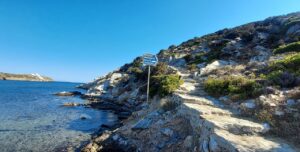
Trail from Katavati to Vathi
Having thoroughly enjoyed the previous days sea side walk, I felt the need for something more rustic / rural. I therefore chose Trail # 5 which starts in Katavati, a neighbouring village of Apollonia … heads in a south westerly direction … ending on the other side of the island in the bay of Vathi, some 9 kms away.
Initially the starting point was a little hard to find, but eventually the well marked “red and white” signs were located. Setting off at 11 am on a forecast to be hot day, I was unprepared for the magnitude of the trek ahead, especially during the heat of the day !

A friendly young Belgium couple coming down from the mountain guided me to the correct starting point. Incredulous that I was attempting the trek on my own, they warned me of the need for both water and hat, both of which I had.
They had been on a separate trail to the mountain top Monastery of Profit Ilias, which seemed to hang like a cloud in the sky on a distant mountain top. Good luck they proffered !!
As you leave the town behind the terrain becomes rugged with the track following along the side of a long valley. Whilst the trails are intermittently dotted with the welcome “red and white” sign posts, its easy to get distracted with the scenery and veer off onto the wrong path.
Along the way you can’t help but marvel at the amount of man hours that must have been expended in getting these rocky paths and supporting stone walls built.
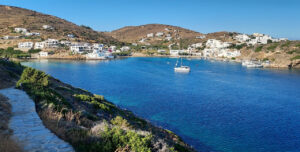
An hour into the walk I managed to get lost and stumbled across an immaculately kept chapel known as Agios Efstathios (Agios means Saint), in such a remote location that I could not understand who would use its divine facilities, let alone maintain it in such immaculate condition, I would see many more such strange phenomenon in the next four hours. It seems the Greeks are very religious folk !
Further up the valley along the path came the authentic mountain man on his donkey, with another in toe. Clearly this was the only available transport on such a rocky path.
The steep never ending track was starting to take its toll and my water supply was waning as quickly as me. It’s easy to understand how travellers can get into difficulty in such harsh unforgiving terrain.
I found myself constantly looking for the reassuring signs, as there was now little margin for error in getting lost again. It had become a very hot day magnified by the lack of a breeze in the meandering valley I was following.
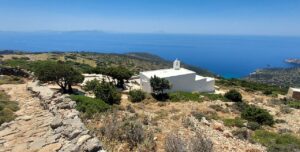
These middle two hours of the six hour trek were the most difficult … up up up on a very rough and rocky path. If I rolled my ankle I would be in serious trouble as there were no other foolhardy souls out there !
Eventually I reached the top of the mountain and caught my first glimpse of the sea out to the west. Even more of a relief was the cool breeze now on offer.
Whilst I was only about half way there, psychologically I was restored knowing that the rest of the hike would be downhill to the sea. In the far distance I could see the faint outline of Kimolos and Milos islands to the south west.
I lost sight of the sea however as the track diverted back inland and along another valley. Along this section however I came across an amazing man made olive grove of approx 20 trees.
Such an unusual place … totally isolated was the small well kept white house with no one home. Perhaps this was where the mountain man lived with his two donkeys !
It was such a peaceful setting (apart from the incessant low key chant of caccadis) that I had a 15 minute rest and savoured the serenity of the landscape … and my last remaining water.
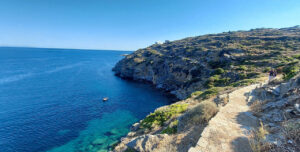
Moving on from this surreal inland place, I again found the view of the sea and the welcoming zephyr of a breeze lifted my spirits. An hour later I caught the first glimpse of Vathi Bay approx two kms below in the distance … a welcoming and beautiful sight indeed.
So it was around 5 pm when I staggered off the track and onto the lovely beach at the northern end of the bay. (a superb almost land locked bay with a narrow entry passage). There were many yachts moored and people enjoying the beach. A nicer swim I doubt I have ever had … and the icy cold Alpha beer at a seaside taverna has never tasted better.
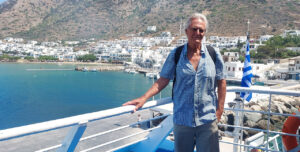
Vathi is a very special tranquil place that I was sad to leave on the 6pm bus back to Apollonia. I vowed to myself that I would return and explore this amazingly beautiful bay … with more time and energy.
Leaving Sifnos the following morning I realised that I had not allocated enough time to explore this unique and lovely island. I would recommend at least 4 days, if not more.
Sifnos was the 18th Greek Island I have visited, and certainly one of the best for its natural beauty, unique traditional villages, stunning beaches … and the charming low key vibe. I strongly recommend it to those looking for an alternative authentic Greek Island experience.
Gaverides is an Australian now living in Greece. Over the past 20 years he has travelled extensively to Athens, throughout the Greek islands and the more remote mainland areas of this wonderful country. He enjoys writing about his adventures in Greece, and in particular the journeys that take him there.






